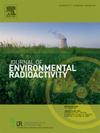Using radioactive waste for targeted alpha therapy: Advancing a sovereign Australian supply of 225Ac and 212Pb
IF 2.1
3区 环境科学与生态学
Q3 ENVIRONMENTAL SCIENCES
引用次数: 0
Abstract
This review outlines an opportunity to convert radioactive waste into nuclear medicine cancer treatments. Whilst focussed on Australia, parallels can be drawn to the identification and exploitation of radioactive waste internationally. Targeted Alpha (α) Therapy treatments (TATs) are emerging as a ‘game changer’ in the efficacy of nuclear medicine treatments in terms of cancer regression and remission, patient survival and quality of life. Clinically, TATs have demonstrated unprecedented efficacy in patients who have failed all other lines of radiotherapy treatment using beta-emitting isotopes. By 2030, ∼60 % of all radiotherapy treatment will be administered as TATs. Unfortunately, few cancer patients receive this treatment due to a limited sovereign and global supply of precursor radionuclides. This review focusses on the identification of radioactive waste streams that may allow the separation of 228Ra and 226Ra isotopes. Radionuclide transmutation allows production of 225Ac and 212Pb as key therapeutic TATs. Key findings indicate that the viability of creating theranostic isotopes from radioactive waste will depend on; identifying suitable sources to eliminate sovereign supply risk; securing access to, or ownership of, suitable sources; radionuclide activity within source; composition and mineralogy influencing extraction and selectivity for target radionuclides; safe residue disposal; volume/mass of current or legacy sources; regulatory and policy guidance; risk profile; advocacy from peak medical associations; and, investment capital to establish infrastructure and pilot production facilities. Prospective sources for the target 228Ra and 226Ra isotopes include; reverse osmosis brine reject, barren lixiviant or tailings derived from uranium mining; oil and gas industry scales or produced waters, critical mineral processing solutes and solids; and legacy research sources.

利用放射性废物进行靶向α治疗:推进澳大利亚225Ac和212Pb的主权供应
这篇综述概述了将放射性废物转化为核医学癌症治疗的机会。虽然重点放在澳大利亚,但可以与国际上放射性废物的识别和利用相提并论。靶向α (α)疗法(tat)正在成为核医学治疗在癌症消退和缓解、患者生存和生活质量方面疗效的“游戏规则改变者”。在临床上,TATs在使用β -发射同位素进行所有其他放射治疗失败的患者中显示出前所未有的疗效。到2030年,所有放射治疗的60%将作为TATs进行。不幸的是,由于主权和全球的前体放射性核素供应有限,很少有癌症患者接受这种治疗。本文的重点是鉴定可能允许分离228Ra和226Ra同位素的放射性废物流。放射性核素嬗变允许产生225Ac和212Pb作为关键的治疗tat。主要研究结果表明,从放射性废物中制造治疗性同位素的可行性将取决于;确定合适的来源以消除主权供应风险;确保获得或拥有合适的资源;源内放射性核素活度;成分和矿物学对靶放射性核素提取和选择性的影响安全的残留物处理;当前或遗留源的体积/质量;监管和政策指导;风险预测;来自顶级医学协会的倡导;并投入资金建立基础设施和中试生产设施。228Ra和226Ra目标同位素的潜在来源包括:反渗透卤水废液、贫浸剂或铀矿尾矿;石油和天然气工业的水垢或采出水、关键矿物加工的溶质和固体;还有遗留的研究资源。
本文章由计算机程序翻译,如有差异,请以英文原文为准。
求助全文
约1分钟内获得全文
求助全文
来源期刊

Journal of environmental radioactivity
环境科学-环境科学
CiteScore
4.70
自引率
13.00%
发文量
209
审稿时长
73 days
期刊介绍:
The Journal of Environmental Radioactivity provides a coherent international forum for publication of original research or review papers on any aspect of the occurrence of radioactivity in natural systems.
Relevant subject areas range from applications of environmental radionuclides as mechanistic or timescale tracers of natural processes to assessments of the radioecological or radiological effects of ambient radioactivity. Papers deal with naturally occurring nuclides or with those created and released by man through nuclear weapons manufacture and testing, energy production, fuel-cycle technology, etc. Reports on radioactivity in the oceans, sediments, rivers, lakes, groundwaters, soils, atmosphere and all divisions of the biosphere are welcomed, but these should not simply be of a monitoring nature unless the data are particularly innovative.
 求助内容:
求助内容: 应助结果提醒方式:
应助结果提醒方式:


